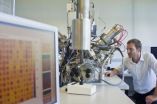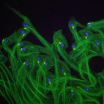(Press-News.org) Aberrant regulation of cell growth pathways is required for normal cells to become cancerous, and in many types of cancer, cell growth is driven by a group of enzymes known as receptor tyrosine kinases (RTKs). The RTK epidermal growth factor receptor (EGFR) is overexpressed in over 30% of breast cancers; however, drugs that target RTKs, known as tyrosine kinase inhibitors (TKIs) have not been effective in treating breast cancer. Researchers believe that the cancer cells escape TKIs by circumventing the RTKs and utilizing other enzymes that are not TKI-sensitive.
In the current issue of the Journal of Clinical Investigation, two groups identify a pair of related oncogenes, FAM83A and B, which allow breast cancer cells to survive TKI treatment. Researchers led by Mina Bissell at the Lawrence Berkeley National Laboratory in Berkeley, CA performed a screen of human breast cancer cell lines to identify genes that make cancer cells resistant to EGFR TKIs. Bissell and colleagues determined that increased expression of FAM83A increases proliferation and invasion, while decreased expression delays tumor growth in mice and renders cancer cells sensitive to TKIs. At Case Western Reserve Medical School in Cleveland, OH, Mark Jackson and colleagues identified FAM83B as a gene that allows normal human mammary cells to become malignant. Further, expression of FAM83A and B in human tumors was correlated with decreased overall survival. Taken together, these studies identify two genes that may serve as novel therapeutic targets. In a companion piece, Steven Grant of the Medical College of Virginia discusses the impact of this research on the development of strategies to overcome resistance to currently available TKIs.
###
TITLE:
Identification of FAM83B as a novel intermediary in EGFR/RAS-mediated transformation
AUTHOR CONTACT:
Mark Jackson
Case Western Reserve University School of Medicine, Cleveland, OH, USA
Phone: 216-368-1276; E-mail: mwj7@case.edu
ACCOMPANYING ARTICLE
TITLE:
FAM83A confers EGFR-TKI resistance in breast cancer cells and in mice
AUTHOR CONTACT:
Mina Bissell
Lawrence Berkeley National Laboratory, Berkeley, CA, USA
Phone: 510 486-4365; E-mail: mjbissell@lbl.gov
ACCOMPANYING COMMENTARY
TITLE:
FAM83A and FAM83B: candidate oncogenes and TKI resistance mediators
AUTHOR CONTACT:
Steven Grant
Medical College of Virginia, Richmond, VA, USA
E-mail: stgrant@vcu.edu
New class of proteins allows breast cancer cells to evade tyrosine kinase inhibitors
2012-08-13
ELSE PRESS RELEASES FROM THIS DATE:
Common antibiotics pose a rare risk of severe liver injury in older patients
2012-08-13
Please credit CMAJ, not the Canadian Medical Association. CMAJ is an independent medical journal; views expressed here do not necessarily reflect those of its owner, the CMA. END ...
Protein that helps tumor blood vessels mature could make cancer drugs more effective
2012-08-13
ORLANDO, Fla., August 13, 2012 – To survive, tumors need blood supply to provide them with nutrients and oxygen. To get that supply, cancer cells stimulate new blood vessel growth—a process called tumor angiogenesis. Many attempts have been made to inhibit this process as a means to choke off tumors. But tumor angiogenesis can be sloppy, resulting in immature and malformed blood vessels. Since anti-cancer drugs are carried to tumors by the bloodstream, abnormal blood vessel development also hampers delivery. What if, rather than putting a stop to angiogenesis, we could ...
Journal of Clinical Investigation early table of contents for Aug. 13, 2012
2012-08-13
New class of proteins allows breast cancer cells to evade Tyrosine Kinase Inhibitors
Aberrant regulation of cell growth pathways is required for normal cells to become cancerous, and in many types of cancer, cell growth is driven by a group of enzymes known as receptor tyrosine kinases (RTKs). The RTK epidermal growth factor receptor (EGFR) is overexpressed in over 30% of breast cancers; however, drugs that target RTKs, known as tyrosine kinase inhibitors (TKIs) have not been effective in treating breast cancer. Researchers believe that the cancer cells escape TKIs by ...
CNIO researchers discover a new therapy that prevents lung cancer growth in mice
2012-08-13
Lung cancer is one of the most aggressive types of cancer and the most common cause of death from this disease worldwide. Despite the progress in the molecular biology of lung cancer achieved in recent years, the mechanisms used by tumor cells to grow and spread throughout the body are not yet completely understood. This lack of information is responsible for the limited range of available therapeutic possibilities and their undesirable side effects.
The Tumour Suppression Group of the Spanish National Cancer Research Centre (CNIO), led by Manuel Serrano, has deciphered ...
Fruity science halves fat in chocolate
2012-08-13
Scientists have found a way to replace up to 50 per cent of chocolate's fat content with fruit juice.
University of Warwick chemists have taken out much of the cocoa butter and milk fats that go into chocolate bars, substituting them with tiny droplets of juice measuring under 30 microns in diameter.
They infused orange and cranberry juice into milk, dark and white chocolate using what is known as a Pickering emulsion.
Crucially, the clever chemistry does not take away the chocolatey 'mouth-feel' given by the fatty ingredients.
This is because the new technique maintains ...
New bacteria-resistant materials discovered
2012-08-13
Using state-of-the-art technology scientists at The University of Nottingham have discovered a new class of polymers that are resistant to bacterial attachment. These new materials could lead to a significant reduction in hospital infections and medical device failures.
Medical device associated infections can lead to systemic infections or device failure, costing the NHS £1bn a year. Affecting many commonly used devices including urinary and venous catheters — bacteria form communities known as biofilms. This 'strength in numbers approach' protects them against the bodies' ...
The ins and outs of building the sperm tail
2012-08-13
Sperm swim, lung cells sweep mucus away, and the cells in the female Fallopian tube move eggs from the ovary to the uterus. Underlying these phenomena are flagella – slender, hair-like structures extending from the surface of the cells, that bend, beat or wave rhythmically. In the latest issue of the journal Developmental Cell*, scientists from the Instituto Gulbenkian de Ciência (IGC), in Portugal, have dissected how sperm cells of the fruit fly build their flagella. These findings pave the way to further understand the molecules and processes that may trigger a variety ...
NTU scientist invents pocket living room TV
2012-08-13
Leaving your TV show midway because you had to leave your home will no longer happen as you can now 'pull' the programme on your TV screen onto your tablet and continue watching it seamlessly.
You can also watch the same TV show or movie together with your family and friends, no matter which part of the world they are in. Not only that but you'll be able to discuss the show, whether you are on your personal tablet or smart phone, through a channel of your choice, be it video chat, voice or text.
The world's first 'pick up and throw back' video feature allows your video ...
Smoking increases, while alcohol consumption may decrease risk of ALS
2012-08-13
A population-based case-control study of the rare but devastating neurological disease amyotrophic lateral sclerosis (ALS) has shown that the risk of such disease is increased among smokers, as has been shown previously. However, surprisingly, the risk of ALS was found to be markedly lower among consumers of alcohol than among abstainers.
Forum reviewers thought that this was a well-done and important paper, as it is a population-based analysis, with almost 500 cases of ALS, a very large number of cases for this rare disease. They were especially struck by the magnitude ...
Clemson researchers make optical fibers from common materials
2012-08-13
CLEMSON — Clemson researchers are taking common materials to uncommon places by transforming easily obtainable and affordable materials into fiber. Their findings are published in Nature Photonics, the world's top journal focused on light-based technologies.
"We have used a highly purified version of beach sand (silica) for fiber for the last 40 years," said John Ballato, director of the Center for Optical Materials Science and Engineering Technologies at Clemson University. "As a matter of fact, the 2009 Nobel Prize in Physics was awarded for the development of silica ...



